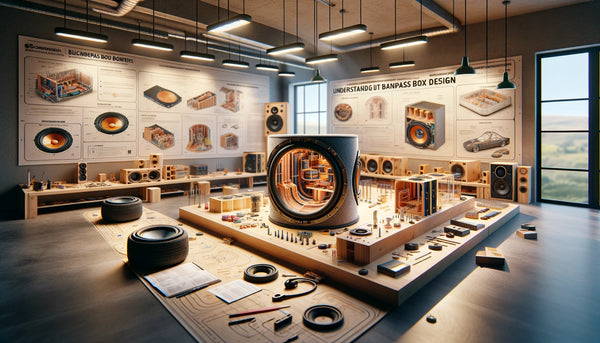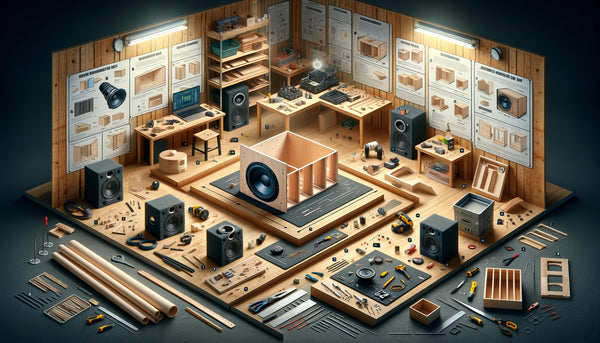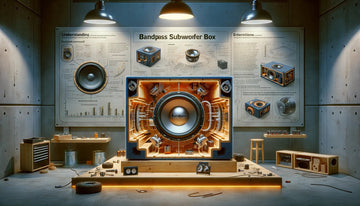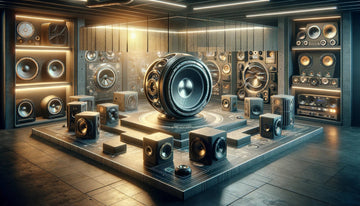
Bandpass Box Design Tips and Tricks
When optimizing your audio system for the deepest and most impactful bass, mastering the intricacies of bandpass box design is critical. This article is crafted to guide you through the essential tips and tricks that will help you unlock the full potential of your bandpass subwoofer box. From understanding the fundamental principles that govern these unique enclosures to implementing advanced design strategies, we're here to provide the knowledge you need to enhance your audio experience.
Navigating the complexities of bandpass box design can be a game-changer for audiophiles and casual listeners. In this piece, we will break down the critical aspects of design, such as selecting suitable materials, calculating optimal dimensions, and fine-tuning for peak performance. Whether you're building from scratch or looking to refine an existing setup, our expert advice will steer you towards achieving that perfect balance of clarity and depth in your bass response.
Master the Art of Bass: Invest in a Premium Bandpass Subwoofer Box Now!
Understanding Bandpass Box Design

Bandpass box design involves optimizing acoustics and dimensions: the smaller enclosure size and the length of the port impact sub-performance. Understanding the inch dimensions, VR, IM, and ft³ capacities is essential for an efficient bandpass box design. A bandpass box's effectiveness depends on the port's size and the sub's capabilities.
Basics of Bandpass Box Design
The basics of bandpass box design revolve around the concept of bandpass and optimizing the enclosure for the best low-frequency response. A bandpass box is specifically designed to emphasize the bass frequencies, providing deep and powerful bass reproduction. By carefully tuning the port size, length, and enclosure design, a bandpass box can achieve a narrow frequency response, emphasizing specific bass frequencies. This design is particularly beneficial for subwoofers, as it amplifies low frequencies while filtering out unwanted sound. The frequency response of a bandpass box is a critical factor, ensuring that the box provides a smooth and controlled sound output within the desired frequency range.
Key Characteristics of a Good Bandpass Box
A good bandpass box design encompasses several key characteristics that enhance sound quality and performance. Sound quality is paramount, and a well-designed bandpass box ensures optimal reproduction of low frequencies. Another essential characteristic is the transient response, which refers to the box's ability to accurately reproduce the sound's initial attack and subsequent decay. The rear chamber of the bandpass box, combined with the port, plays a crucial role in achieving the desired sound quality and transient response. Similarly, with its sealed configuration, the front chamber controls the sound pressure inside the box, further enhancing the bass response.
The Role of Acoustics in Bandpass Box Design

Acoustics is vital in bandpass box design, specifically related to sound quality and frequency response. The design of the bandpass box, including the enclosure size, port length, and dimensions of the front and rear chamber, significantly influences the sound quality produced by the system. The acoustics of the box determine how sound waves interact within the enclosure, affecting the frequency response and the overall audio experience. One can achieve better sound quality, extended frequency response, and more controlled bass reproduction by focusing on proper enclosure design and optimizing the acoustics.
Acoustic Challenges in Bandpass Box Design
Bandpass box design presents unique acoustic challenges that must be addressed for optimal sound performance. One such challenge is dealing with low frequencies, which can be challenging to reproduce accurately without distortion or unwanted resonances. Another challenge is controlling air pressure within the box, as improper pressure management can lead to port noise or suboptimal sound quality. These acoustic challenges, such as achieving the necessary volume displacement at different frequencies to produce the desired db spl, require careful consideration of the box's size and port length and the configuration of the rear and front chambers. By overcoming these challenges and integrating the proper size port, one can achieve a bandpass box design with excellent sound quality and bass response.
Overcoming Acoustic Barriers: Tips and Tricks
Overcoming the acoustic barriers in bandpass box design involves implementing several tips and tricks to optimize sound quality and performance. Here are some strategies to consider:
- Adjusting the tuning frequency by tuning the bandpass box to the desired frequency response.
- Appropriately size the port length, considering the desired bass response and the enclosure size.
- Optimizing the enclosure size for the specific subwoofer, achieving the best performance within the given space constraints.
By following these tips and tricks, you can overcome the acoustic barriers associated with bandpass box design, resulting in a system that delivers the desired sound quality, bass response, and transient response.
Types of Bandpass Enclosures
There are different bandpass enclosures, each with its characteristics and advantages. The two primary types are sealed and ported chamber bandpass enclosures. Sealed chamber bandpass enclosures utilize a sealed chamber for the front of the subwoofer, while ported chamber bandpass enclosures feature a ported rear chamber. Additionally, universal bandpass designs offer versatility, allowing for compatibility with various subwoofer specifications and sound system requirements. These designs provide flexibility regarding subwoofer box size, configuration, and amplifier watts, catering to different audio system setups.
Sealed Chamber Bandpass Enclosure
The sealed chamber bandpass enclosure enhances sound quality, precise frequency response, and lower-frequency extension. This design consists of a sealed front chamber and a ported rear chamber, allowing sound to escape through the port. The sealed chamber controls the subwoofer's low-frequency response, producing accurate bass reproduction. By carefully selecting the front chamber's dimensions, tuning the ported rear chamber, and optimizing the overall enclosure size, the sealed chamber bandpass enclosure can deliver outstanding sound quality, especially in the lower frequency range, making it a popular choice among audio enthusiasts.
Ported Chamber Bandpass Enclosure
The ported chamber bandpass enclosure emphasizes air pressure, transient response, and sound pressure optimization. This design features a ported rear chamber that acts as a low pass filter, complementing the subwoofer's front chamber and acoustically limiting the high-frequency response of the subwoofer system. The ported chamber allows air to escape, increasing the subwoofer's output at specific frequencies. Optimizing the port area, length, and tuning frequency is crucial in achieving the desired sound quality and bass response. The vented design of the ported chamber bandpass enclosure significantly influences the subwoofer's low-frequency response, providing a deeper, more pronounced bass sound. This design is particularly suitable for audio systems that require robust, impactful bass reproduction through a woofer.
Universal Bandpass Designs
Universal bandpass designs offer versatility and adaptability, catering to a wide range of subwoofer specifications and sound system requirements. These designs provide the flexibility to accommodate different subwoofer box sizes, configurations, and amplifier watts, ensuring compatibility with various audio systems. By implementing a universal bandpass design, audio enthusiasts and professionals can optimize subwoofer displacement, cone area, and loudspeaker design, tailoring the bandpass enclosure to the specific audio system's needs. The versatility of the universal bandpass design allows for fine-tuning of the bandpass, ported, and sealed enclosures, ensuring optimal sound quality, transient response, and bass output in different audio setups.
Step-by-step Guide to Building a Bandpass Box

Building a bandpass box requires careful attention to enclosure design and configuration. Follow this step-by-step guide to ensure a successful bandpass box build:
Preparing the Design Concept
Before starting the build process, having a clear design concept in mind is essential. Consider the following parameters:
- Select the appropriate loudspeaker design that will best complement the bandpass enclosure.
- Determine the desired parameters, such as the enclosure size, port length, and tuning frequency, based on the subwoofer's specifications.
- Consider the available space in the vehicle or room and the bandpass box design constraints.
Calculating Enclosure Dimensions
Calculating the enclosure dimensions accurately is crucial for optimal bandpass box performance. Pay attention to the following aspects:
- Measure the subwoofer's cubic foot displacement and modify the enclosure size accordingly, allowing sufficient space for the subwoofer to function optimally.
- Adjust the bandpass enclosure size, considering the subwoofer's displacement, to prevent any issues related to the subwoofer cone excursion.
Selecting the Right Materials
When choosing materials for your bandpass box, prioritize high-quality options to ensure optimal performance. Additionally, carefully select the port width to minimize air noise and consider a vented chamber design for efficient bass reflex. Durable materials are essential for sealed chamber construction, and opting for materials that enhance sound quality is crucial. By prioritizing these factors, you can ensure that the materials contribute to the overall performance of your bandpass box.
Assembling the Bandpass Box
Assembling the bandpass enclosure requires precision to ensure optimal sound quality. Following the bandpass box tutorial for proper subwoofer installation, the sealed box configuration is essential for airtight construction. It's crucial to use suitable bandpass box parameters for the loudspeaker design and to install the subwoofer with the correct coil configuration. Additionally, paying attention to the more minor enclosure details, such as the length and size of the port, can significantly impact the overall performance.
Tuning Your Bandpass Box

When tuning your bandpass box, consider the optimal tuning frequency for the front chamber to enhance performance. Adjust the dimensions of the port to achieve the desired sound characteristics, ensuring it complements the smaller enclosure. The size of the port is crucial in determining the resonance and overall acoustics. Optimizing the sub's characteristics, such as its inch, VR, IM, and FT, is vital in maximizing the box's potential.
Tips on Tuning Frequency of the Front Chamber
Achieving the desired bandpass response in a bandpass box involves tuning the front chamber. This can be done by adjusting the bandpass box tuning frequency to achieve the optimal passband. It's important to fine-tune the front chamber dimensions to ensure the best bandpass response. Using a bandpass box tutorial can help set the tuning frequency accurately, optimizing the front chamber configuration for an ideal octave response. Additionally, considering the smaller enclosure and the size of the port is crucial for achieving the desired outcome.
Adjusting the Dimensions of the Port
To achieve optimal performance of the bandpass box, the configuration should be optimized to minimize air noise. The ported chamber design must be adjusted to ensure the best bandpass response while modifying the front chamber dimensions optimizes the bass reflex. Ensuring that the vented chamber design enhances sound quality is crucial, and fine-tuning the port length is essential for achieving the optimal bandpass enclosure size. Paying careful attention to these adjustments will significantly impact the overall performance of the bandpass box.
Maximizing the Performance of Your Bandpass Box

When striving to maximize the performance of your bandpass box, consider employing techniques to linearize the frequency response and increase sensitivity and bandwidth. Adjust the port's length to fine-tune the front chamber's tuning frequency. Additionally, optimizing the size of the port ensures efficient airflow, enhancing overall sound quality. Experiment with different sub-sizes, such as 10-inch or 12-inch, and explore variations in volume (VR) and impedance (IM) to achieve the desired acoustics. For smaller enclosures, carefully calculate the dimensions in cubic feet to maintain optimal performance.
Linearizing the Frequency Response
To achieve a consistently smooth frequency response in bandpass box design, optimizing the subwoofer response using specific parameters is crucial. The size of the bandpass box enclosure plays a crucial role in maximizing the frequency response, so a smaller enclosure can be advantageous. Additionally, fine-tuning the tuning frequency and configuring the port area is essential to ensure the best sound quality and performance. Further, consider the length and size of the port and the sub, inch, vr, im, and ft to optimize the frequency response for your bandpass box design.
Increasing Sensitivity and Bandwidth
Consider a proper enclosure design to optimize the frequencies your subwoofer can produce. Additionally, choosing a subwoofer with a higher sensitivity rating can produce more sound with less power. You might also consider using a small enclosure with a ported design to increase bandwidth and output. It's essential to use high-quality materials for your enclosure, including MDF and sound-deadening materials. Experimenting with different box designs and configurations can help you find the best fit for your subwoofer and car audio system.
Are There Variations to the 4th Order Bandpass Enclosure?
Yes, variations to the 4th-order bandpass enclosure exist. These include asymmetrical designs with different-sized chambers for the front and rear of the subwoofer and dual-chamber designs that feature two separate enclosures for the front and rear of the subwoofer.
Conclusion

In conclusion, designing a bandpass box requires careful consideration of acoustics, enclosure types, and tuning. To achieve optimal performance, it is essential to understand the basics and critical characteristics of a good bandpass box. Overcoming acoustic challenges can be done with the help of some tips and tricks. Additionally, following a step-by-step guide will ensure the proper construction of the bandpass box. Maximizing performance involves linearizing the frequency response and increasing sensitivity and bandwidth. While the 4th-order bandpass enclosure is commonly used, variations offer different benefits. By implementing these strategies, you can create a bandpass box that delivers exceptional sound quality and meets your audio needs. Happy designing!

















